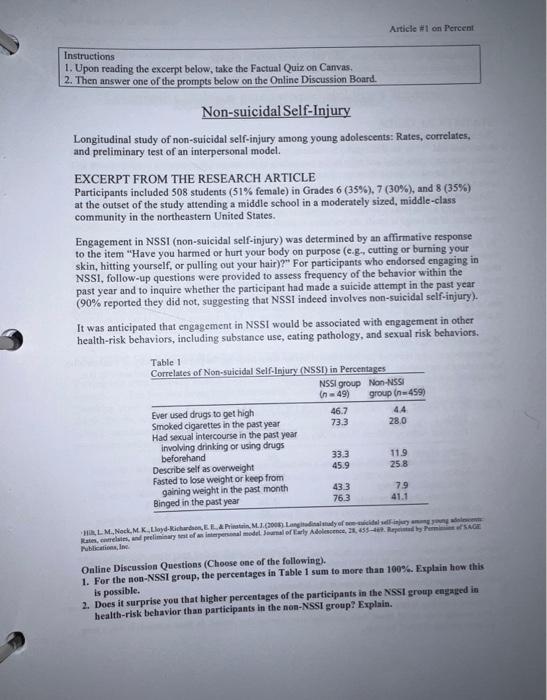Answered step by step
Verified Expert Solution
Question
1 Approved Answer
PLEASE NEED HELP WITH THE QUESTIONS 1 AND 2 AT THE BOTTOM Instructions 1. Upon reading the excerpt below, take the Factual Quiz on Carvas,
PLEASE NEED HELP WITH THE QUESTIONS 1 AND 2 AT THE BOTTOM 
Instructions 1. Upon reading the excerpt below, take the Factual Quiz on Carvas, 2. Then answer one of the prompts below on the Online Discussion Board. Non-suicidal Self-Injury Longitudinal study of non-suicidal self-injury among young adolescents: Rates, correlates, and preliminary test of an interpersonal model. EXCERPT FROM THE RESEARCH ARTICLE Participants included 508 students ( 51% female) in Grades 6(35%),7(30%), and 8(35%) at the outset of the study attending a middle school in a moderately sized, middle-class community in the northeastern United States. Engagement in NSSI (non-suicidal self-injury) was determined by an affirmative response to the item "Have you harmed or hurt your body on purpose (e.g., cutting or burning your skin, hitting yourself, or pulling out your hair)?" For participants who endorsed engaging in NSSI, follow-up questions were provided to assess frequency of the behavior within the past year and to inquire whether the participant had made a suicide attempt in the past year ( 90% reported they did not, suggesting that NSSI indeed involves non-suicidal self-injury). It was anticipated that engagement in NSSI would be associated with engagement in other health-risk behaviors, including substance use, eating pathology, and sexual risk behaviors. Rublestions, ine. Online Discussion Questions (Choose one of the following). 1. For the non-NSSI group, the percentages in Table 1 sum to more than 100%. Explain how this is possible. 2. Does it surprise you that higher percentages of the participants in the NSSI group engaged in health-risk behavior than participants in the non-NSSI group? Explain. Instructions 1. Upon reading the excerpt below, take the Factual Quiz on Carvas, 2. Then answer one of the prompts below on the Online Discussion Board. Non-suicidal Self-Injury Longitudinal study of non-suicidal self-injury among young adolescents: Rates, correlates, and preliminary test of an interpersonal model. EXCERPT FROM THE RESEARCH ARTICLE Participants included 508 students ( 51% female) in Grades 6(35%),7(30%), and 8(35%) at the outset of the study attending a middle school in a moderately sized, middle-class community in the northeastern United States. Engagement in NSSI (non-suicidal self-injury) was determined by an affirmative response to the item "Have you harmed or hurt your body on purpose (e.g., cutting or burning your skin, hitting yourself, or pulling out your hair)?" For participants who endorsed engaging in NSSI, follow-up questions were provided to assess frequency of the behavior within the past year and to inquire whether the participant had made a suicide attempt in the past year ( 90% reported they did not, suggesting that NSSI indeed involves non-suicidal self-injury). It was anticipated that engagement in NSSI would be associated with engagement in other health-risk behaviors, including substance use, eating pathology, and sexual risk behaviors. Rublestions, ine. Online Discussion Questions (Choose one of the following). 1. For the non-NSSI group, the percentages in Table 1 sum to more than 100%. Explain how this is possible. 2. Does it surprise you that higher percentages of the participants in the NSSI group engaged in health-risk behavior than participants in the non-NSSI group? Explain 
Step by Step Solution
There are 3 Steps involved in it
Step: 1

Get Instant Access to Expert-Tailored Solutions
See step-by-step solutions with expert insights and AI powered tools for academic success
Step: 2

Step: 3

Ace Your Homework with AI
Get the answers you need in no time with our AI-driven, step-by-step assistance
Get Started


